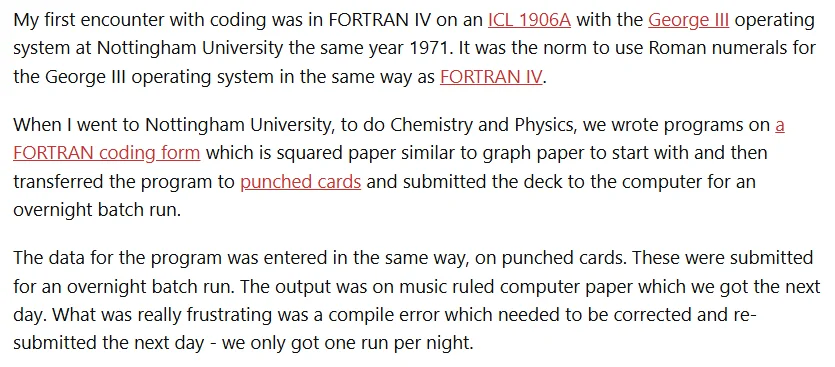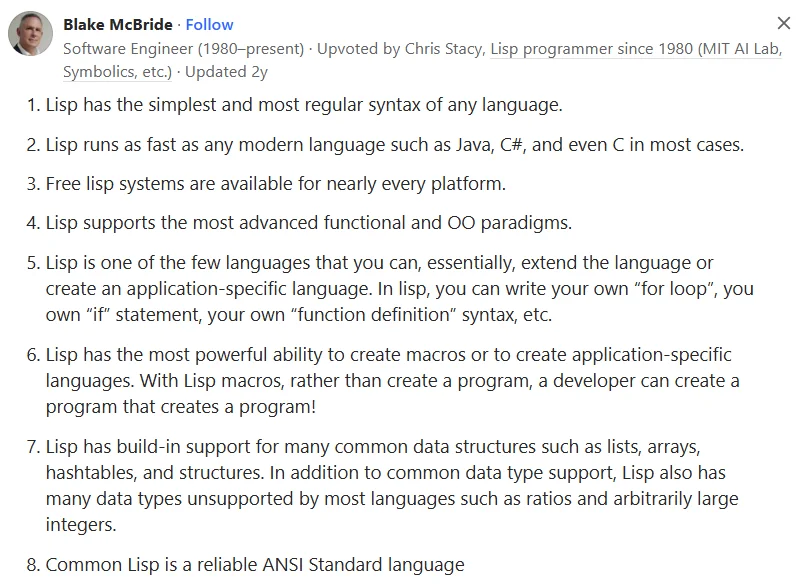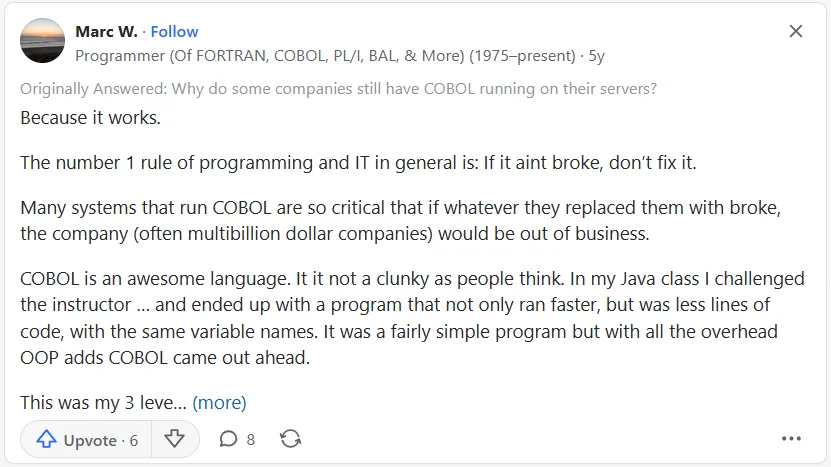
You might be far removed from the IT sphere but have definitely heard of Python, PHP, JavaScript, Java, and C++. You likely think that large corporations, banking systems, and government institutions use these languages because they guarantee top-notch security, cutting-edge features, and make it easier to find skilled professionals. However, the pandemic (remember those times?) revealed that in the 21st century, governments and businesses across all countries, including the USA, the UK, and Germany, still rely on old programming languages. Some of them are 40–60 years old but continue to power ATMs, aerospace technology, military systems, medical devices, and other critical equipment.
At Cityhost, we respect old programming languages but prefer modern technologies to provide comfortable and secure website management. With us, you can rent hosting with the latest PHP versions, enabling you to easily install modern CMS, generate dynamic content, integrate third-party services, improve performance, and enhance your website's security.
- Fortran — the foundation of scientific calculations and computations
- Lisp — data processing and artificial intelligence
- COBOL — key processes of corporations and government institutions
- Pascal — from education to business and commercial programs
- C — an old programming language as a foundation for new ones
- Ada — ensuring the safety of critical systems
- MATLAB — a comprehensive environment for computations
- Why old programming languages are still in use
Fortran — the foundation of scientific calculations and computations
Fortran (Formula Translation) is a commercial old programming language developed by the American electronics corporation IBM in 1957. The development was initiated by John Backus and his team of programmers, who proposed creating a practical alternative to assembly language to the company’s management in 1953. The project was completed in 1954 and published in 1957. The first three versions have become obsolete, but the next three oldest versions (Fortran IV and Fortran 66) are still in use, while three more modern versions (Fortran 77, Fortran 90, Fortran 95) are the most widely used.

Here’s an excerpt from a Stack Overflow forum post, where you can find fascinating stories about first programming experiences.
Although Fortran is the oldest commercial programming language, it is still used by leading scientists at NASA and the U.S. Department of Energy. This comes as no surprise, given its incredibly robust built-in support for numerical calculations and array manipulations — perfect for scientists and engineers who consider Python and Java too slow. Moreover, scientific researcher Ondřej Čertík is working on two projects to revive Fortran: the LFortran compiler, which translates Fortran into modern programming languages, and the Fortran Lang developer website. New versions are also in the works, with the F202Y update potentially giving Fortran a “new lease on life”.
Lisp — data processing and artificial intelligence
Lisp (short for "list processing") is an old programming language created in 1958 by John McCarthy to simplify string data manipulation. In Lisp, computations are expressed as functions of at least one object, which can be other functions, elements, or data structures. The first implementation was done by Steve Russell on an IBM 704 mainframe using punched cards. It was subsequently improved over time, especially between 1960 and 2000, during which dozens of dialects were developed.

On the Quora forum, you can learn more about the features and experiences of working with Lisp, as well as its advantages and disadvantages.
Although Lisp is less popular than Python, its ability to perform calculations using symbolic expressions rather than numbers makes it highly suitable for AI programs. It is actively used by AI programmers, quantum computing specialists, in robotics, and in scientific research. The Grammarly service uses Common Lisp (an extended and practical version of basic Lisp) for text analysis and improvement, while Boeing uses it to support their servers. The Clojure dialect is actively employed by Amazon, Capital One, and Walmart.
Learn more about the Ukrainian decacorn Grammarly in the article: Fantastic Beasts and Business: What Is a Unicorn Company and How to Identify One
COBOL — key processes of corporations and government institutions
COBOL (Common Business-Oriented Language) is an old programming language designed to work with large amounts of textual information and financial data. In 1959, the rising cost of programming became a pressing issue, prompting the Conference on Data Systems Languages (CODASYL) to create a business-oriented language specifically for financial systems. The CODASYL project was supported by the U.S. Department of Defense, which required computer manufacturers to implement COBOL on their machines. This led to its rapid adoption, making it an integral part of government and business infrastructures.
In 2020, COBOL brought attention to old programming languages that are still actively used in government institutions. During the coronavirus crisis, the unemployment system of New Jersey, which still runs on COBOL, faced unprecedented demand. At the time, Governor Phil Murphy called on technical experts to help balance the system’s workload.

Excerpt from the Intelligencer Journal, April 6, 2020. You can read the full original article and the governor’s statement via the provided link.
In today’s world, with numerous programming languages, COBOL is still widely used in business, administrative, and financial databases. According to Reuters, in 2017, $3 trillion in trade flowed daily through systems running on COBOL. The situation has not changed much since then, as Common Business-Oriented Language remains the foundation for deposit accounts, ATMs, mortgage services, and other operations.
Read also: Which IT professions to study in 2024 — how not to be left without work in the most popular industry
Pascal — from education to business and commercial programs
Pascal is an old procedural programming language based on the principles of structured programming, which emphasizes dividing code into procedures and functions to enhance readability and reusability. It was developed by Swiss programmer and computer scientist Niklaus Wirth in 1970. Initially, Pascal was used for teaching structured programming, but it later became a powerful tool for developing business and commercial applications, gaining particular popularity in the 1980s and 1990s.
Pascal’s main advantages include its simple syntax, reduced errors in writing and compiling code due to the structured programming model, the ability to create cross-platform programs, and support for object-oriented programming principles. These benefits keep it relevant even 50 years after its creation:
- the original Apple Aqua interface was written in Pascal and remains a core part of macOS;
- the virtual environment StreamOS, popular among game and software developers, is entirely written in Pascal;
- Europe’s largest international conglomerate, Siemens, still uses this old programming language for components of its medical equipment;
- the visual programming language Delphi, based on Object Pascal, remains popular for developing Windows applications.
According to the TheirStack platform, 2 851 companies use Pascal. Most users are in France (300), the USA (246), the Netherlands (200), and Germany (198). While Pascal significantly lags behind even other old programming languages like MATLAB (used by 32 600 companies) and COBOL (9 300 companies), let alone modern competitors, each of which is used by over 200 000 companies, it still holds a niche role in various industries.
C — an old programming language as a foundation for new ones
C is one of the oldest general-purpose programming languages, supporting both low- and high-level functions simultaneously. It was created in the early 1970s by computer scientist Dennis Ritchie, who was working at the American corporation AT&T Bell Labs. Ritchie aimed to improve the UNIX operating system with multi-computer support. The B language was no longer suitable for such tasks, so Ritchie built upon much of its syntax while making significant changes. In 1972, C was first used on a DEC PDP-11 computer.
The simplicity, numerous built-in functions, high execution speed, ability to break complex programs into simpler ones, and many other advantages made C one of the most popular programming languages of the 1980s. It is still actively used to support:
- database management systems and infrastructure optimization (e.g., Google);
- programs for translating source code into machine code (compilers);
- operating system components, including Linux and Windows;
- games and animations using libraries such as OpenGL, SDL, and SFML;
- drivers and software (e.g., Intel).
This old programming language serves as the foundation for many modern ones, including C++, Java, JavaScript, PHP, and Python. For example, C++ is essentially an extension of C, adding object-oriented programming (OOP). Java employs similar control structures, while Python has many internal components written in C and inherits comparable program flow control ideas.
Ada — ensuring the safety of critical systems
Ada is an old programming language designed for the development of critical systems. Between 1977 and 1983, the U.S. Department of Defense sought to replace more than 450 outdated languages with a single efficient, reliable, and powerful solution for embedded computer systems. The Department of Defense was instrumental in popularizing this new project: by 1991, they mandated the use of Ada for all software development. Other NATO countries, particularly Sweden, Canada, and Germany, also favored this programming language.
There are several reasons why the old programming language Ada remains actively used:
- strong typing ensures precise data type definitions and checks;
- support for modular architecture and hierarchical package organization facilitates better code structure;
- built-in mechanisms for multitasking and parallel processing enhance performance;
- support for object-oriented programming principles ensures flexibility and scalability;
- seamless adaptation across various hardware platforms broadens its usability.
Ada is ideally suited for critical systems, such as software for aircraft, satellite and spacecraft control, radar programs, weapons and combat aircraft management, nuclear power plant operations, train automation, and more. For example, the following were written in Ada:
- the Fly-by-wire software in the Boeing 777;
- Canada’s automated air traffic control system;
- the UK’s iFACTS air traffic management system;
- suburban train control systems in Paris, London, Hong Kong, and New York.
Interesting fact: The language was named after Ada Lovelace, the first programmer in history. Learn more about other women who contributed to computer science and technology in the article: Women Inventors in Mathematics and Technology.
MATLAB — a comprehensive environment for computations
MATLAB (Matrix Laboratory) is a programming language and environment for technical and scientific computing, developed by MathWorks. In 1967, it began as a hobby project for students by mathematics professor Cleve Moler, who distributed copies to universities, thereby attracting the interest of mathematics departments. Initially, MATLAB was a simple interactive matrix calculator, but it later evolved into a universal tool for computations, data analysis, modeling, visualization, and algorithm development.
In 1984, MathWorks was founded, and the MATLAB programming language was officially released. In 1985, Nick Trefethen, a student at the Massachusetts Institute of Technology, made the first purchase of ten copies. Today, MATLAB is used by over 5 million users worldwide, including engineers, scientists, educators, and researchers. Together with Simulink — a block diagram environment for modeling complex multi-domain systems — it enables the design, development, and operation of electric vehicles and airplanes, marine vessels, manufacturing equipment, and smart medical devices.
Why old programming languages are still in use
Stability, reliability, and the high cost of transitioning are the key reasons old programming languages continue to be used in the modern world.
As highlighted in this article, the challenge of finding qualified specialists for languages like Fortran, COBOL, Lisp, Ada, and others becomes more pressing each year. Reports from the Advanced Software platform indicate that 89% of companies are concerned about the shortage of IT personnel, and universities no longer offer training courses for old programming languages. Few aspire to learn them for use in new projects, favoring Python, Java, JavaScript, C#, PHP, and others instead.
However, the principle "if it ain't broke, don't fix it" often prevails. Programs created decades ago continue to perform their functions effectively: for instance, banking systems written in COBOL have ensured stable transactions for over 50 years. In many companies, systems in old languages contain millions of lines of code, so transitioning them to modern alternatives requires enormous resources and risks critical errors. Furthermore, newer languages aren’t always superior. Fortran remains a leader in scientific computations, and COBOL excels in financial systems.

Quora post: The forum hosts dozens of explanations from programmers specializing in COBOL, Fortran, and other legacy languages.
The shortage of specialists is indeed a serious issue. However, in most cases, maintaining existing projects in old programming languages is safer and more cost-effective. These systems have worked reliably for decades without major issues. Business owners understand this and often opt for gradual modernization and training of new programmers rather than abandoning older technologies altogether.










